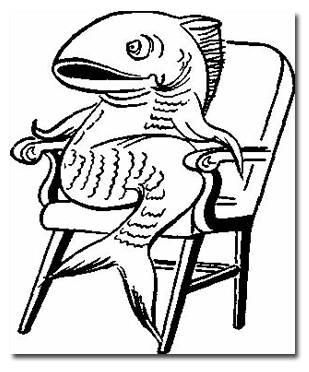
How To Develop A Super Power Memory > Contents > Link Method of Memory
I want to show you now, that you can start, immediately, to remember as you've never remembered before. I don't believe that anyone with an untrained memory can possibly remember twenty unassociated items, in sequence, after hearing or seeing them only once. Even though you don't believe it either, you will accomplish just that if you read and study this chapter. Before going into the actual memorizing, I must explain that your trained memory will be based almost entirely on mental pictures or images. These mental pictures will be easily recalled if they are made as ridiculous as you can possibly make them. Here are the twenty items that you will be able to memorize in sequence in a surprisingly short time. carpet, paper, bottle, bed, fish, chair, window, telephone, cigarette, nail, typewriter, shoe, microphone, pen, television set, plate, donut, car, coffee pot, and brick. A famous man once said that method is the mother of memory. So, I'll teach you now, what I call the Link method of memory. I've told you that your trained memory will consist mostly of ridiculous mental images, so let's make ridiculous mental images of the above twenty items! Don't be alarmed! It is child's play; as a matter of fact it is almost like a game. The first thing you have to do is to get a picture of the first item, "carpet," in your mind. You all know what a carpet is—so just "see" it in your mind's eye. Don't just see the word, "carpet," but actually, for a second, see either any carpet, or, a carpet that is in your own home and is therefore familiar to you. I have already told you that in order to remember anything, it must be associated in some way to something you already know or remember. You are going to do that right now, and the items themselves will serve as the things you already remember. The thing that you now know or already remember is the item, "carpet". The new thing, the thing you want to remember will be the second item, "paper". Now then, here is your first and most important step towards your trained memory. You must now associate or link carpet to, or with, paper. The association must be as ridiculous as possible. For example, you might picture the carpet in your home made out of paper. See yourself walking on it, and actually hearing the paper crinkle under foot. You can picture yourself writing something on a carpet instead of paper. Either one of these is a ridiculous picture or association. A sheet of paper lying on a carpet would not make a good association. It is too logical! Your mental picture must be ridiculous or illogical. Take my word for the fact that if your association is a logical one, you will not remember it. Now, here is the point which I will keep reminding you of throughout this book. You must actually see this ridiculous picture in your mind for a fraction of a second. Please do not just try to see the words, but definitely see the picture you've decided on. Close your eyes for a second; that might make it easier to see the picture, at first. As soon as you see it, stop thinking about it and go on to your next step. The thing you now already know or remember is, "paper," therefore the next step is to associate or Link, paper to the next item on the list, which is, "bottle". At this point, you pay no attention to "carpet" any longer. Make an entirely new ridiculous mental picture with, or between bottle and paper. You might see yourself reading a gigantic bottle instead of a paper, or writing on a gigantic bottle instead of on paper. Or, you might picture a bottle pouring paper out of its mouth instead of liquid; or a bottle made out of paper instead of glass. Pick the association which you think is most ridiculous and see it in your mind's eye for a moment. I cannot stress, too much, the necessity of actually seeing this picture in your mind's eye, and making the mental image as ridiculous as possible. You are not, however, to stop and think for fifteen minutes to find the most illogical association; the first ridiculous one that comes to mind is usually the best to use. I'll give you two or more ways in which you might form your pictures with each pair of the twenty items. You are to pick the one that you think is most ridiculous, or one that you've thought of yourself, and use that one association only. We have already linked carpet to paper, and then paper to bottle. We now come to the next item which is, "bed". You must make a ridiculous association between bottle and bed. A bottle lying on a bed, or anything like that would be too logical. So you might picture yourself sleeping in a large bottle instead of a bed, or you might see yourself taking a snort from a bed instead of a bottle. (I can get pretty ridiculous.) See either of these pictures in your mind for a moment, then stop thinking of it. You realize, of course, that we are always associating the previous object to the present object. Since we have just used, "bed"; this is the previous, or the thing we already know and remember. The present object, or the new thing that we want to remember, is "fish". So—make a ridiculous association or link between bed and fish. You could "see" a giant fish sleeping in your bed; or a bed made out of a gigantic fish. See the picture you think is most ridiculous. Now—"fish" and "chair"—see the gigantic fish sitting on a chair, or a large fish being used as a chair. Or, you're catching chairs instead of fish while fishing.
Chair and Window—See yourself sitting on a pane of glass (which gives you a pain) instead of a chair. Or, you might see yourself violently throwing chairs through a closed window. See the picture before going on to the next one. Window and Telephone—See yourself answering the phone, but when you put it to your ear, it's not a phone you're holding, but a window. Or, you might see your window as a large telephone dial, and you have to lift the dial to look out the window. You could see yourself sticking your hand through a window pane in order to pick up the phone. See the picture you think is most ridiculous, for a moment. Telephone and Cigarette—You're smoking a telephone instead of a cigarette; or you're holding a large cigarette to your ear and talking into it instead of a telephone. Or, you might see yourself picking up the phone and a million cigarettes fly out of the mouthpiece and hit you in the face. Cigarette and Nail—You're smoking a nail; or hammering a lit cigarette into the wall instead of a nail. Nail and Typewriter—You're hammering a gigantic nail right through a typewriter, or all the keys on your typewriter are nails and they're pricking your fingertips as you type-Typewriter and Shoe—See yourself wearing typewriters instead of shoes, or you're typing with your shoes. You might want to see a large shoe with keys and you're typing on that. Shoe and Microphone—You're wearing microphones instead of shoes, or, you're broadcasting into a large shoe. Microphone and Pen—You're writing with a microphone instead of a pen, or you're broadcasting and talking into a giant pen. Pen and Television set—You could "see" a million pens gushing out of the television screen, or pens performing on television, or there is a screen on a gigantic pen and you're (I can't resist this pun) watch-ink a television show on it. Television set and Plate—Picture your television screen as one of your kitchen plates, or see yourself eating out of the television set instead of out of a plate, or—you're eating out of a plate, and seeing a television show in the plate while you eat. Plate and Donut—"See" yourself biting into a donut, but it cracks in your mouth for it's a plate. Or, picture being served dinner in a gigantic donut instead of a plate. Donut and Automobile—You can "see" a large donut driving an automobile; or, see yourself driving a gigantic donut instead of a car. Automobile and Coffee Pot—A large coffee pot is driving a car, or you're driving a gigantic coffee pot instead of a car. You might picture your car on your stove, with coffee perking in it. Coffee Pot and Brick—See yourself pouring steaming coffee from a brick instead of a coffee pot, or "see" bricks pouring from the spout of a coffee pot instead of coffee. That's it! If you have actually "seen" these mental pictures in your mind's eye, you will have no trouble remembering the twenty items in sequence, from "carpet" to "brick." Of course, it takes many times the length of time to explain this than to simply do it. Each mental association must be seen for just the smallest fraction of a second, before going on to the next one. Let's see now if you have remembered all the items. If you were to "see" a carpet, what would that bring to mind immediately? Why, paper, of course. You saw yourself writing on a carpet, instead of paper. Now, paper brings bottle to mind, because you saw a bottle made of paper. You saw yourself sleeping in a gigantic bottle instead of a bed; the bed had a gigantic fish sleeping on it; you were fishing, and catching chairs and you were flinging chairs through your closed window. Try it! You will see that you will go right through all the items without missing or forgetting any of them. Fantastic?? Unbelievable?? Yes! But, as you can see, entirely plausible and possible. Why not try making your own list of objects and memorizing them in the way that you have just learned. I realize, of course, that we have all been brought up to think logically, and here I am, telling you to make illogical or ridiculous pictures. I know that with some of you, this may be a bit of a problem, at first. You may have a little difficulty in making those ridiculous pictures. However, after doing it for just a little while, the first picture that comes to mind will be a ridiculous or illogical one. Until that happens, here are four simple rules to help you.
1. Out of Proportion. 2. Action. 3. Exaggeration. 4. Substitution. Try to get one or more of the above into your pictures, and with a little practice you'll find that a ridiculous association for any two items will come to mind instantly. The objects to be remembered are actually linked one to the other, forming a chain, and that is why I call this the Link method of remembering. The entire Link method boils down to this:—Associate the first item to the second, the second to the third, third to the fourth, and so on. Make your associations as ridiculous and/or illogical as possible, and most important, SEE the pictures in your mind's eye. In later chapters you will learn some practical applications of the Link system—how it can help you to recall your daily schedule or errands, and how you can use it to help you remember speeches. The Link system is also used to help memorize long digit numbers and many other things. However, don't jump ahead of yourself; don't worry about those things now. Of course, you can use the Link immediately to help you remember shopping lists, or to show off for your friends. If you want to try this as a memory stunt, have your friend call off a list of objects; have him write them down so that he can check you. If when you try this you find that you are having trouble recalling the first item, I suggest that you associate that item to the person that's testing you. For example, if "carpet" were the first item, you could "see" your friend rolled up in your carpet. Also, if on first trying this as a stunt, you do forget one of the items, ask what it is and strengthen that particular association. You either didn't use a ridiculous enough association, or you didn't see it in your mind, or you would not have forgotten it. After you've strengthened your original association, you'll be able to rattle off the items from first to last. Try it and see! The most impressive part of it, is that if your friend asks you to call off the items two or three hours later, you will be able to do it! They will still be brought to mind by your original associations. If you really want to impress your listeners, call the items off backwards! In other words, from the last item called, right up to the first one. Amazingly enough, this works for you automatically. Just think of the last item, that will recall the next to last item, and so on down, or rather, up the line. By the way, why not try Test # 1 in Chapter # 3 again. Compare your score now, with the score you had before you read this chapter on the Link method. |
Last update:
Back to OwnWays.com
How to Develop a Super Power Memory
Copyright © 2007 OwnWays.com
Some Rights Reserved


